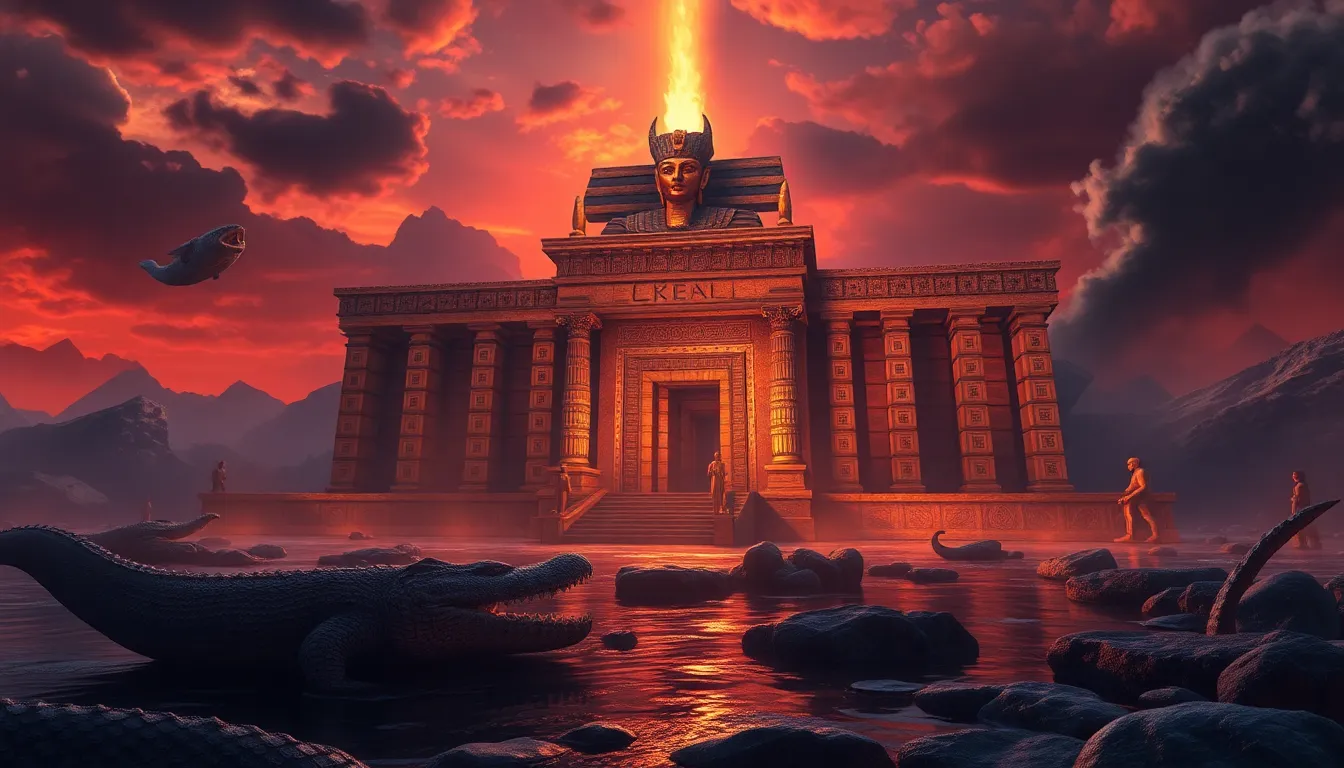The Temple of Sobek: The Crocodile God’s Domain
I. Introduction
Sobek, revered as the Crocodile God, held a significant position in ancient Egyptian mythology. His image often invoked a blend of reverence and fear, embodying the primal forces of nature through the powerful symbolism of the crocodile. As a deity associated with fertility, protection, and the Nile River, Sobek was not merely a fearsome creature; he was integral to the agricultural success and survival of ancient Egyptians.
The Temple of Sobek, located in the ancient city of Kom Ombo, served as a pivotal site for worship and rituals dedicated to this multifaceted god. This article aims to explore the historical background of Sobek, the architectural features of his temple, its geographic significance, the rituals performed there, archaeological discoveries, and the cultural impact Sobek has had throughout history.
II. Historical Background of Sobek
The worship of Sobek dates back to the early dynastic periods of Egypt, where he was initially celebrated as a local deity. Over time, his influence expanded, and he became recognized statewide as a god associated with the Nile’s life-giving properties.
Sobek’s dual nature is particularly fascinating. He was seen as both a creator god, responsible for the creation of the world, and a protector, safeguarding the pharaohs and the people from chaos. Key myths surrounding Sobek include:
- The myth of Sobek’s creation of the Nile from the waters of chaos.
- The story of Sobek fighting against the chaos serpent, Apep, to maintain balance in the universe.
III. Architectural Features of the Temple
The Temple of Sobek is renowned for its unique architectural design, which reflects the harmonious relationship between the divine and the natural world. The temple features a symmetrical layout with numerous chambers and sanctuaries dedicated to Sobek and other deities.
Some of its unique architectural elements include:
- Large courtyards that allowed for public gatherings and rituals.
- Intricate carvings and hieroglyphics that depict myths and offerings to Sobek.
- Granite and sandstone materials, showcasing the advanced engineering skills of the ancient Egyptians.
The symbolism present in the temple’s structure is profound. The crocodile motifs and scenes illustrating Sobek’s protective nature reflect the intertwining of life and death, a central theme in Egyptian spirituality.
IV. Location and Significance
The Temple of Sobek is located in Kom Ombo, which sits on the east bank of the Nile River. Its geographic location highlights Sobek’s association with the Nile, as the river was vital for agriculture and sustenance in ancient Egypt.
In terms of religious practices, the temple played a crucial role in local and national worship. It served as a pilgrimage site for those seeking Sobek’s blessings for fertility and protection. Additionally, Sobek’s connection to the Nile underscores the importance of water management and agriculture in ancient Egyptian society.
V. Rituals and Offerings
At the Temple of Sobek, a variety of rituals were performed to honor the deity and seek his favor. These rituals included:
- Processions along the Nile, where offerings were made to Sobek.
- Animal sacrifices, particularly of crocodiles, which were seen as sacred to him.
- Festivals celebrating the flooding of the Nile, marking the cyclical nature of life.
The offerings made to Sobek varied, but they often included:
- Food items such as bread, beer, and fruits.
- Precious materials like gold and silver, representing wealth and devotion.
- Symbolic objects, including small crocodile figures that were believed to embody the god’s spirit.
The role of priests and priestesses was vital in these ceremonies, as they facilitated communication between the people and the divine, ensuring that Sobek was appeased and honored appropriately.
VI. Archaeological Discoveries
Archaeological excavations at the Temple of Sobek have yielded significant findings that have enriched our understanding of ancient Egyptian society. Some key discoveries include:
- Statues and reliefs depicting Sobek and other deities, providing insights into religious practices.
- Inscriptions that detail rituals and offerings, which help historians piece together the cultural significance of the temple.
- Artifacts relating to daily life, indicating the temple’s role as a center for community gatherings.
Ongoing research continues to uncover details about the temple’s construction and its importance in ancient society. Preservation efforts are also crucial to maintaining the site for future generations.
VII. Cultural Impact and Legacy
Sobek and the Temple of Sobek have left an indelible mark on Egyptian art and literature. The imagery of Sobek has been depicted in various forms, from wall carvings to pottery, illustrating his revered status.
Modern interpretations of Sobek often explore themes of duality—both fear and reverence—reflecting his complex nature. In contemporary culture, the temple attracts numerous tourists, serving as a vital part of Egypt’s cultural heritage, offering insights into the ancient world.
VIII. Conclusion
The Temple of Sobek stands as a testament to the rich tapestry of ancient Egyptian mythology and culture. Its significance is not only rooted in the worship of Sobek but also in its representation of the interconnectedness between the people, their environment, and their beliefs.
As we reflect on the enduring legacy of Sobek, it becomes evident that the themes of fertility, protection, and the cyclical nature of life continue to resonate in modern times. This encourages further exploration and appreciation of ancient Egyptian history, a civilization that has profoundly shaped our understanding of the world.




